Exotic and exciting pets are becoming more and more popular in recent years, as people look to open their homes to pets that are more unique than traditional dogs and cats.
Because of this, more and more people are looking to become owners of lizards, and demand for popular species has skyrocketed in the last decade or two.
However, some breeds can require extensive equipment and housing, costing thousands upon thousands of dollars, while others can be very sensitive and prone to illness or injury.
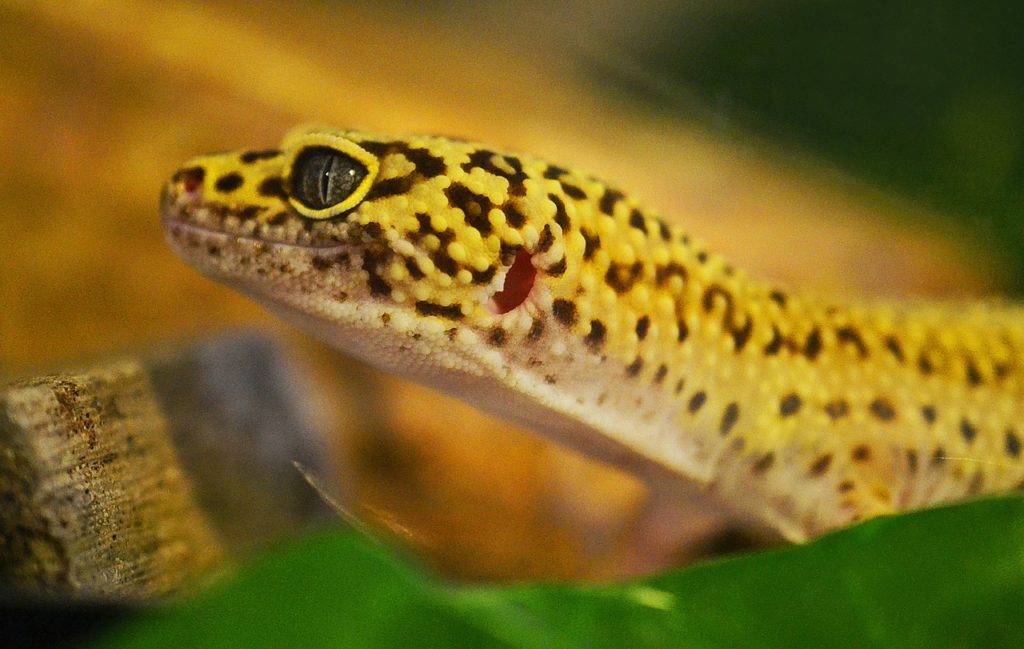
We’ve compiled a handy list of the top 5 types of pet lizards to keep, for beginners and experienced reptile owners alike.
Quick Navigation
What You Should Look For in a Pet Lizard
While the list below does include some of the most popular choices for low-maintenance pet lizards, you may already have a specific breed or sub species in mind.
But how can you decide whether you can handle your dream lizard? Below are a list of important factors that you should consider before making your decision.
- Lifespan – Can you commit to taking care of your pet for the duration of its life? Some pet lizards can live for over 20 years! A pet is a lifelong commitment, so be sure you’ll be able to care for your lizard through its full life expectancy.
- Set Up – What type of setup to they require? Can you afford to provide what they need?
- Ongoing care – What supplies do they need for their ongoing care, and does the equipment they need have large ongoing costs? For example, electricity to power lights can add up over time. Is the food they eat expensive or hard to source?
- Treatment – Is the breed you want hardy? Does it have inherent health conditions? Can you afford to treat these issues should they arise?
- Skills and Knowledge – Do you have the specific skills and knowledge required to correctly care for your chosen breed? For example, do you know how to handle your breed of choice correctly?
- Temperament – Are you looking for a pet you can enjoy watching, or do you want to be able to actively handle your pet? Does the breed you have in mind have a suitable temperament for either of these options?
- Time and Commitments – Does caring for your lizard of choice take a considerable amount of time? Do you have any pre-existing commitments that could impact your level of care?
- Safety – If you’re opting for a larger lizard and you have young children, or care for an individual in ill health, then you might need to consider their safety. Larger lizards can break bones with a whip of their tail, not to mention that they can have a nasty bite!
4 Beginner Friendly Pet Lizards
Listed below are some of the most highly recommended lizards for beginners or those looking for a lizard that is low maintenance.
While these all require relatively simple care and set-up, it is important to remember that any pet will constitute a considerable commitment, and before purchasing you should be 100% sure that you can meet your new pet’s needs throughout its entire lifespan.
You should undertake thorough research and consider your own specific circumstances and wants and needs before you make any type of purchase.
1. Leopard Gecko (Eublepharis macularius)
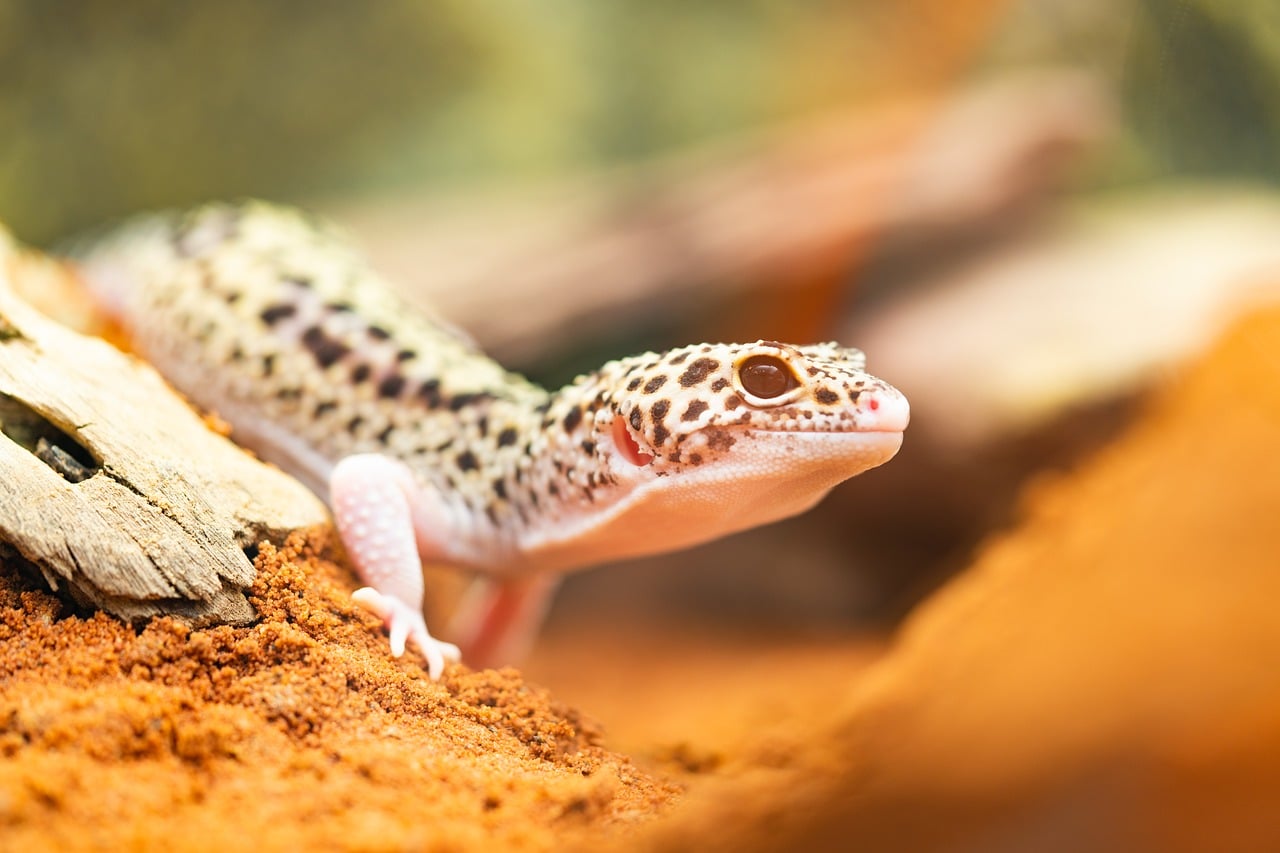
The Leopard Gecko is probably the number one most popular lizard kept as a pet in the United States, and with their charming little faces and bright happy eyes, it’s not hard to see why!
These small reptiles usually grow no larger than 7-10 inches, and come in a variety of pretty colorations.
One of the largests factors that make Leopard Geckos so beginner friendly is how little equipment they require.
A standard a 20 gallon tank will make the perfect home for your gecko.
Additional Reading: How to Set up a Leopard Gecko Habitat
Unlike a large proportion of lizards, Leopard Geckos are nocturnal, which means they sleep in the day and are active at night.
This means they do not require specific lighting such as for basking, which greatly reduces the level of complexity in regards to their setup, and minimizes their future costs in regards to electricity bills and expensive equipment.
The only specific consideration you need to make is regulating the heating in the room your gecko is housed.
Like all reptiles, Leopard Geckos are cold-blooded. This means that unlike humans and other mammals, who can warm or cool their own bodies, your gecko’s temperature is reflective of their external environment.
Therefore, when the room is cold, so is your gecko, and when the room is hot the gecko will be also.
Geckos are also very easy to feed. When juvenile and growing, they will require feeding every day. However, once they reach full maturity this can be changed to every other day.
In regards to feeding, an adult Leopard Gecko really is one of the most low maintenance, as they can go a few days without food perfectly safely or unaffected, meaning they are great for those leading busy lives.
In a similar vein, Leopard Geckos are also very hardy and seldom suffer with ailments or problems like other lizards might.
Leopard Geckos can reach and even exceed 20 years of age. While this does mean you are making a long-term commitment, it also does mean that you can form a strong bond with your Gecko over the years and have a real companionship.
In regards to being your companion, Leopard Geckos, unlike other species of gecko, make the perfect pet. Whereas other species of Gecko have sticky toe pads, which allow them to climb most surfaces, making escape attempts a more regular possibility,
Leopard Geckos do not have these, meaning they are at a much lower risk of escaping.
Leopard Geckos are different to other geckos as well because they are much slower and more relaxed in temperament, meaning they can be easily handled by beginners.
They are also quite characterful little creatures and will get in to all kinds of antics as they explore and play in their home, making them great to watch.
2. Bearded Dragon (Pogona Vitticeps)
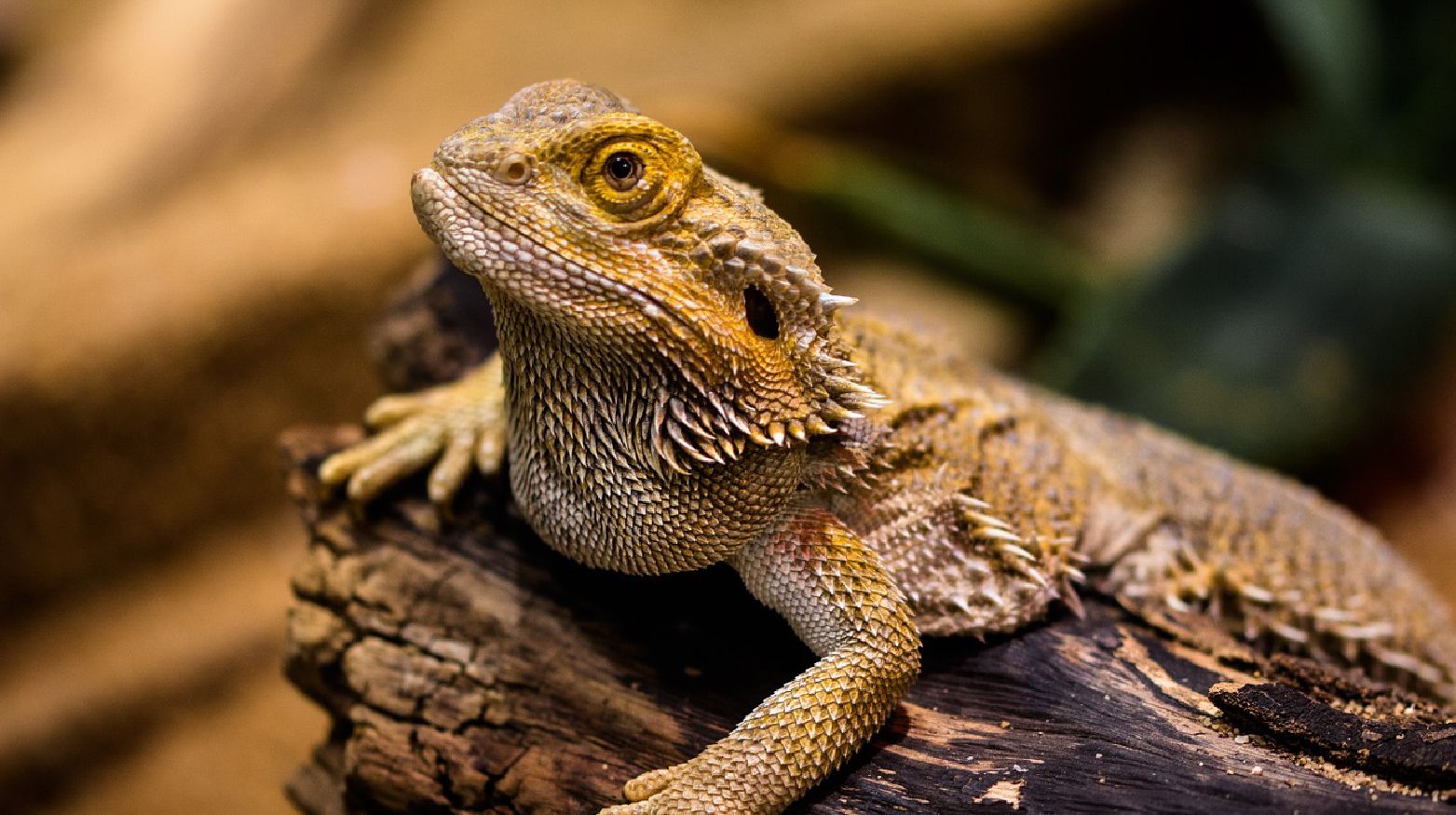
Bearded Dragons are probably the second most popular lizard owned at home, and while they do take a little more maintenance and set up considerations than Leopard Geckos, Beardies, as they are affectionately known, make great and rewarding pets for those looking to own a larger lizard.
With a lifespan of around 8-10 years, with some well cared for Beardies living to around 15 years of age, Bearded Dragons are a commitment similar to owning a dog.
In terms of size, depending on both the care they received when growing, as well as gender, beardies can reach around 14-24 inches.
In regards to set up, an adult bearded dragon will require a minimum tank size of around 48″ x 24″ x 24″.
Additional Reading: How to Set Up a Bearded Dragon Habitat
Unlike Leopard Geckos, Bearded Dragons are diurnal, meaning that like humans they are awake during the day, and asleep during the nighttime.
Because of this, they will require specialized lighting, such as UVB lamps, as well as a tank set up that gives both space for basking, as well as spaces to hide, cool off, and sleep.
As with all reptiles, they will also need a temperature-controlled environment, and will typically require heat lamps.
While without the correct care Bearded Dragons can be susceptible to health complaints and illnesses, so long as you follow the right care instructions and are aware of some of the signs and symptoms of common ailments, these issues can usually either be avoided, or dealt with quickly and easily.
The main struggle that first time Bearded Dragon owners might encounter is brumation. While some Bearded Dragons might never brumate, others may do it as often as yearly.
Put simply, brumation is a bearded dragon’s version of hibernation, which they use in the wild to survive the winter months.
This can be an anxious time for lizard-owning newbies, but there is a wealth of information and support available online, and your vet will be happy to help you if you suspect your bearded dragon may be entering brumation.
In terms of temperament, Beardies have one of the best of all lizards commonly kept as pets.
They are happy to be handled, and unlike many reptiles can actually show recognition and will seek out their owner if looked after properly.
3. Blue Tongued Skink
Blue-tongued (Tiliqua spp.) skinks are another great pet lizard for beginners, and they exhibit a number of the same traits that make bearded dragons such a good choice for novices.
Most notably, blue-tongued skinks reach large enough sizes that they’re easy to handle, yet they don’t grow so large that they present housing challenges. They’re usually quite docile too, and they rarely object to calm, gentle handling by their keeper.
Blue-tongued skinks are also omnivores, who are relatively easy to feed. You’ll want to keep their menu varied, but a combination of insects, fresh fruits and vegetables, as well as the occasional bit of commercial blue-tongued skink food will usually keep them healthy and happy. Additionally, these foods are all relatively easy to procure.
Advanced keepers disagree about the need for full-spectrum lighting for these lizards. Many provide lighting that includes UVB rays, but others feel this is an unnecessary complication.
Because the problems caused by inadequate lighting can be severe, I always advocate for erring on the side of caution when in doubt. So, I’ve usually provided full-spectrum lighting to any blue-tongued skinks in my care. However, plenty of other keepers appear to have had success without using elaborate lighting.
You’ll simply need to research the needs of blue-tongued skinks, consult with your lizard’s vet, and make the best decision you can on behalf of your pet.
Nevertheless, even if we were to consider UVB lighting mandatory for these lizards, that still means they require the same basic type of care that bearded dragons do. This makes it easy to understand why we consider them one of the best lizards for beginning keepers.
4. Crested Gecko (Rhacodactylus ciliatus)
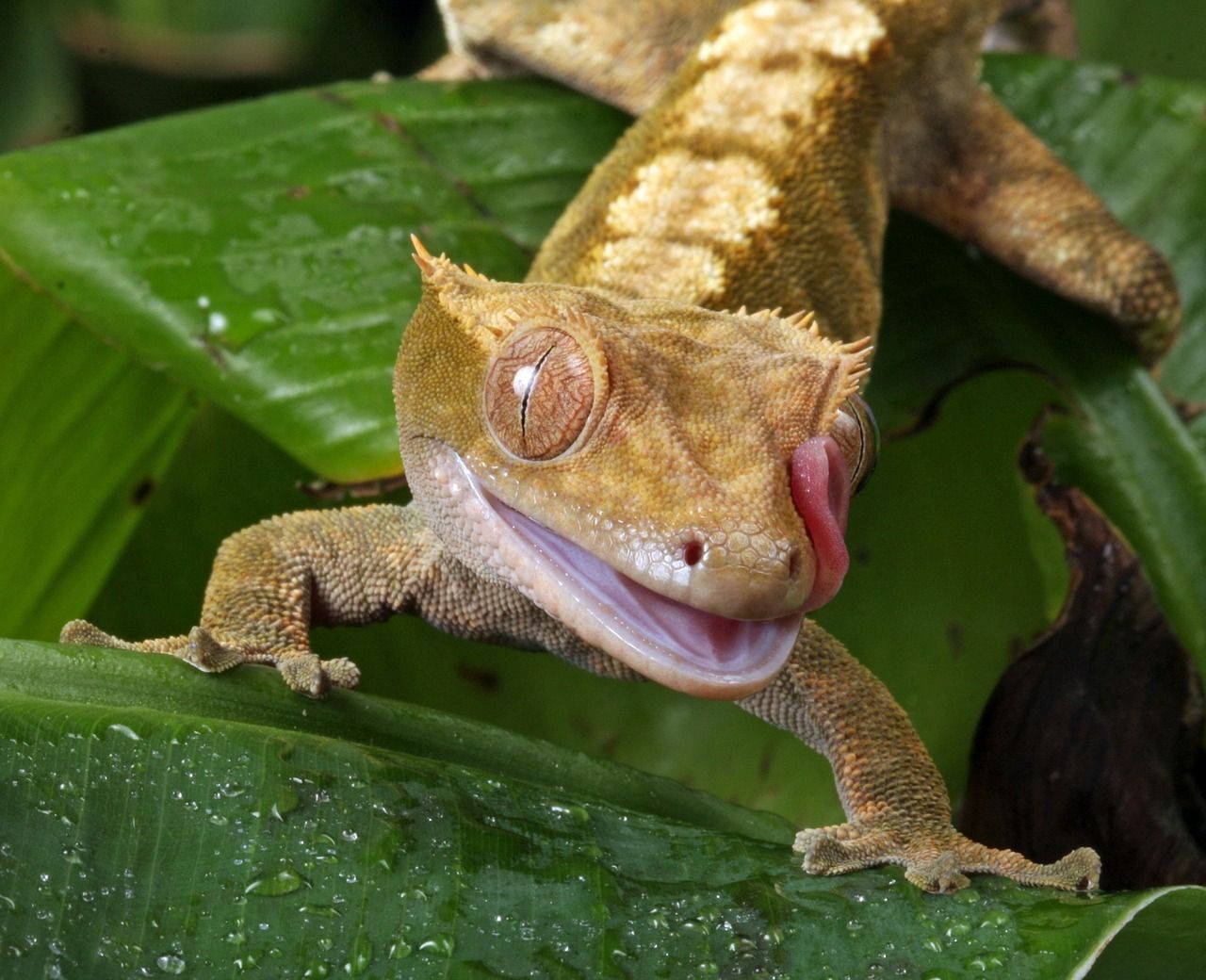
The second gecko on our list, the Crested Gecko is becoming rapidly more popular in recent years.
More reptilian- or snake-looking than the Leopard Gecko, the Crested Gecko is typically golden in color and can have stripes or spots or a combination of both.
The striking look of these geckos often has them at the top of many beginners wishlists.
Crested Geckos are described as ‘arboreal’, which means they like to climb within their tank onto leaves and foliage.
They use their sticky toe pads to help them do this, and this can cause potential escape risks, meaning that owners need to ensure their tank is secure and escape-proof.
This of course can incur further costs to owners, but many find this worth it when it comes to watching their gecko climb around their environment.
While it was previously mentioned that geckos can be very fast and not suitable for handling, like the Leopard Gecko the Crested Gecko is quite slow and docile, meaning they can be easily handled without the worry of them escaping your grasp.
The only thing you need to be careful about when handling the Crested Gecko is that this breed is known to be more delicate and fragile than the robust Leopard Gecko.
They are also slightly larger than their Leopard counterparts at between 5-8 inches. They have a slightly shorter lifespan than the Leopard Gecko, however, reaching a top end of 15 years.
Also similar to the Leopard Gecko, the Crested Gecko is heralded as having some of the most simple care requirements of all lizards kept as pets.
They require no special lighting, and unlike almost all lizards, no special heating. In fact, they can actually become quite stressed if the temperature becomes too high.
Additional Reading: How to Set Up a Crested Gecko Habitat
Crested Geckos aren’t picky eaters either and can be fed a diet of pre-packaged fruit-based powders which are mixed with water, making feeding time hassle free.
However, some Crested Gecko owners do prefer to supplement their gecko’s diet with live insects in order to more closely imitate their natural diet in the wild.
Supplementation with insects could be particularly helpful when the gecko is juvenile and is using almost all of its energy for growth.
While Crested Geckos are fascinating to watch in their enclosure, they can be quite shy creatures, and will often choose to hide amongst the foliage of their tank.
They are also nocturnal, meaning that they sleep during the day and are awake at night, meaning they are likely to be inactive during daytime hours.
11 Pet Lizards for Expert Reptile Keepers
If you’re looking for something a bit more unique, read below for 11 of our favorite pet lizard species for advanced reptile keepers.
Please keep in mind – these lizards are not meant for beginners!
1. Chameleons
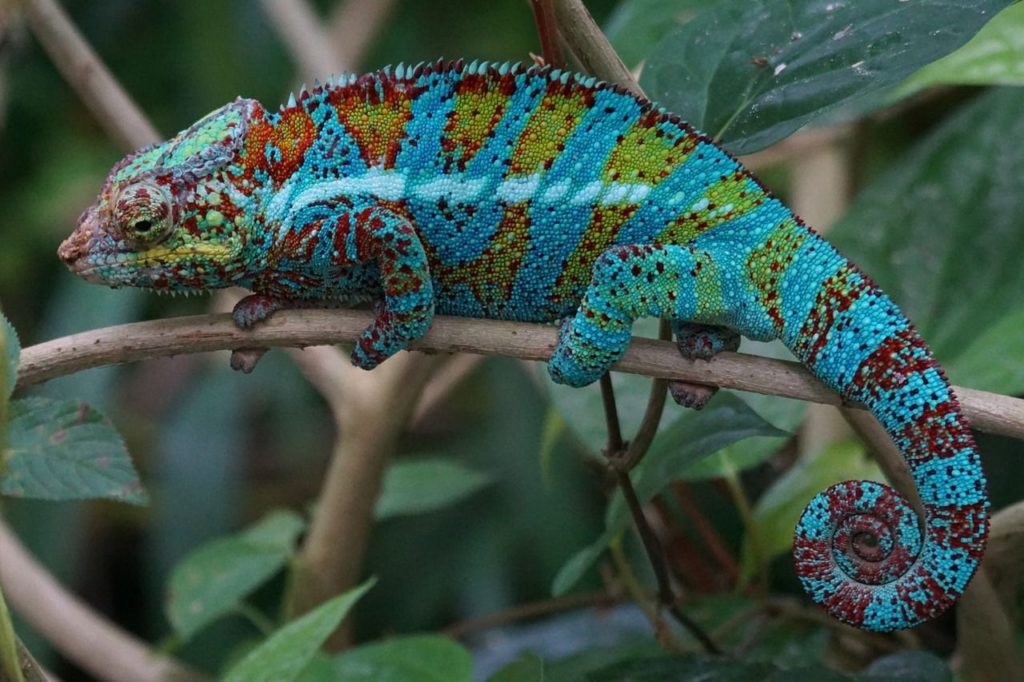
Chameleons – meaning members of the family Chamaeleonidae – are a fascinating group of lizards represented by more than 200 living species. Most are capable of some degree of color change, and a few switch from one bold pattern to the next so rapidly it’ll drop your jaw.
The color-changing abilities of chameleons may be their primary claim to fame, but these lizards exhibit a variety of unusual anatomical features and characteristic behaviors.
For example, their bodies are laterally compressed, their toes are fused into two opposing groups, and their eyes move independently. They may sway back and forth to look like a shaking leaf, and they communicate with other chameleons by changing their colors. And, of course, they use very long, extensible tongues to catch prey.
But chameleons have several unique care requirements, which make them unsuitable for beginners in most cases. For example, they require screened enclosures rather than aquaria, they’re very susceptible to dehydration and a few species are not readily available in captive-bred form.
Intermediate and advanced keepers, however, have a pretty good chance of success with many chameleon species, particularly a few commonly kept species of chameleons:
- Panther chameleon (Furcifer pardalis)
- Veiled chameleon (Chamaeleo calyptratus)
- Jackson’s chameleon (Trioceros jacksonii)
- Parson’s chameleon (Calumma parsonii)
Just be sure that you research the species you intend to keep carefully before making your purchase. Chameleon species differ markedly in their care requirements – they’re definitely not a “one size fits all” group of lizards in terms of husbandry.
Note that anoles (Anolis spp.) are sometimes called chameleons, and unscrupulous pet dealers may try to shoehorn the word “chameleon” into poorly known species to help increase their appeal.
2. Dwarf Monitors
Monitor lizards are remarkably appealing to many reptile enthusiasts. But most of the commonly imported species reach unmanageable sizes or have prickly temperaments. However, there are a handful of monitor species that usually have moderately docile demeanors and remain small enough to accommodate.
Most of these species are members of the subgenus Odatria, with the ridge-tailed monitor (Varanus acanthurus), Kimberly rock monitor (Varanus glauerti) and Pilbara monitor (Varanus pilbarensis) being a few of the most noteworthy examples. In addition to reaching maximum lengths about 2- to 3-feet, these lizards are all bred in captivity, so you won’t have to worry about dealing with wild-caught imports.
Dwarf monitors are also quite striking to behold, and they exhibit a range of interesting behaviors. You can even attempt to breed them yourself if you like. But they do present a few challenges too (which is, after all, why they’re not ideal for beginners).
For starters, these lizards require extremely warm basking sites; some keepers maintain temperatures in excess of 140 degrees Fahrenheit directly under the heat lamp. They also require semi-elaborate cage furniture to replicate the rocks and tree hollows they normally call home.
But experienced keepers who plan sensibly and have the resources available to feed these garbage-disposal lizards may find them to make very enjoyable pets.
3. Leaf-Tailed Geckos
A variety of geckos make good pets for beginners. Leopard geckos are the best-known example, but golden (Gekko badenii), tokay (Gekko gecko) and white-lined geckos (Gekko vittatus) are also relatively easy to maintain. But these geckos are pretty common species, which may not excite experienced keepers.
Fortunately, there are several more challenging, rare and (arguably) more attractive species available. Frog-eyed geckos (Teratoscincus scincus) are one such example, but there’s an entire genus of geckos that may quicken your pulse. Commonly known as leaf-tailed geckos, there are 18 different species within the genus Uroplatus that are guaranteed to catch your attention.
Leaf-tailed geckos get their name from their oddly shaped tails, which typically resemble a leaf. Some even feature “damaged” margins and mottling to help camouflage even more effectively. The rest of a leaf-tailed gecko’s body also bears markings and, in some cases, fringe-like scales too. For that matter, a few species – such as the satanic leaf-tailed gecko (Uroplatus phantasticus) – have bodies that are shaped like leaves.
It’s easy to see why these lizards elicit so much attention, but unfortunately, they’re often pretty tricky to maintain. They do not handle excessive temperatures well at all (80 degrees is considered too warm for many), and most are very susceptible to stress. They’re also most commonly available as wild-caught individuals, although a small number of captive-bred offspring hatch each year.
Just be sure to research the needs of your specific species before making the purchase, as they all inhabit relatively discrete niches in the wild.
4. Uromastyx
Part of what makes some reptiles attractive to advanced keepers is their unusual body plans. You can see this with the chameleons and leaf-tailed geckos we’ve already mentioned. But one of the oddest groups of lizards on the planet has to be the genus Uromastyx.
Sometimes called dab lizards, these medium-sized reptiles typically have flattened, stocky bodies with a heavily armed, spikey tail. In the wild, dab lizards use these tails to block the entrance to their retreats or smack a would-be predator in the face. Fortunately, they rarely use their tails on human handlers.
It is conceivable that beginning reptile keepers could enjoy some success with a uromastyx. However, for a variety of reasons, they’re typically best left to keepers with a bit of experience.
Uromastyx lizards are available as captive-bred specimens, but many that are sold on the pet market are wild-caught. This presents a host of challenges, as most will be parasitized, many will also be dehydrated, and some won’t exhibit strong appetites. You may also find that your new uromastyx has become injured during his time at the pet store or importer.
Additionally, uromastyx lizards require elaborate lighting and heating fixtures, and their largely vegetarian diet may present additional challenges. Experienced keepers should be able to handle these challenges, and those who do will be rewarded mightily for their efforts, as healthy, well-acclimated uromastyx look amazing.
5. Frilled Dragons
Frilled dragons (Chlamydosaurus kingii) are one of the most instantly recognizable lizards on the planet. Equipped with a large flap of skin around their neck (known as a frill), they’ll pull this skin taught when frightened to appear larger and more formidable.
It is an effective defense mechanism, and it helps these medium-sized lizards protect themselves from predators. They’ll even display their erect frills when startled by their keeper, but they tend to do so less often over time. Eventually, most stop extending their frill entirely.
Neck appendages aside, frilled dragons are very interesting lizards, who exhibit a few unusual behavioral adaptations. For example, they tend to spend long periods of time on elevated perches, but they prefer to rest vertically while clinging to tree-like perches, rather than horizontal “branches.” This reflects their habit of clinging to tree trunks in the wild.
Frilled dragons may also walk or hop around bipedally. They rarely do so for the distances that some other lizards (such as basilisks) do, but it is still something you’re sure to see your lizard do at some point in time.
These lizards are not a good choice for first-time keepers, but most people with a bit of experience should be able to succeed with them. Just be sure to pick up a captive-bred specimen, as they’ll adapt better to captivity and be burdened by fewer parasites.
6. Basilisks
Basilisks always command a lot of attention at zoos and reptile expos, but they present a number of husbandry challenges that make them inappropriate for fledgling keepers. For example, basilisks need incredibly large enclosures with large water features.
They are also very flighty, easily spooked lizards, who are prone to running full speed into the habitat walls and glass. But if you start with a captive bred individual and provide him with a spacious, well-planted habitat, you can have some success.
Note that there are several different species of basilisk, but most keepers will find the plumed basilisk (Basiliscus plumifrons) to be the most attractive and appealing species.
7. Legless Lizards
While lizards are typically thought of as having legs, while snakes lack them entirely, there are a few lizard species that have no legs at all. This includes a few North American species, such as the glass lizard (Ophisaurus ventralis), as well as several others from North Africa, Asia and Europe, such as the Russian sheltopusik (Pseudopus apodus).
Aside from their lack of legs, these lizards are pretty similar to other lizards of similar size. They’re often docile, and they are usually easy to care for by those with some experience. They usually eat aggressively, and they don’t require elaborate housing.
The biggest challenges legless lizards present their keepers is the fact that they’re typically wild-caught (and therefore parasitized), and there is simply not a lot of information available about their care and captive needs.
8. Crocodile Skinks
Crocodile skinks (Tribolonotus gracilis) are underappreciated lizards, who not only look very unique, they also exhibit unusual behaviors. For example, they’ll often vocalize or adopt a rigid body posture when frightened.
These lizards don’t present many unique challenges to their keepers, although they do require climbing branches and a high humidity environment. But they’re typically easy to feed and they don’t require very large enclosures.
However, most crocodile skinks available to hobbyists are of the wild-caught variety, so you’ll need to be prepared to work closely with your vet to ensure your lizard is healthy.
9. Day Geckos
Day geckos of the genus Phelsuma are some of the most beautiful lizards available to keepers. The genus contains roughly 70 species, but there are about one or two dozen that are common in captivity.
Most day geckos are clad in green with other colorful spots and markings that help make them stand apart from most other lizards. Unlike many other geckos, these are diurnal lizards (as their common name implies). So, when set up in a well-planted vivarium, they are among the most fantastic-looking inhabitants a keeper could want.
However, day geckos are quite difficult to handle, which makes them inappropriate for new keepers. They’re usually not defensive or inclined to bite, but they are extremely fast. This makes them difficult to catch when you must tend to the habitat, and they also have very fragile skin, which is easy to rip if you try to catch them by hand.
Experienced keepers can usually work around these challenges, but beginners will often end up inadvertently injuring their lizard – sometimes seriously so.
10. Red Ackie
Lesser known than the two previous entries on this list, the Red Ackie is a charming looking lizard that is also known as the ‘ridge-tailed lizard’ or ‘spiny-tailed lizard’.
While the Ackie is of the monitor family, and most lizards in that family should be considered unfriendly to beginners due to their size and temperment, the Red Ackie is far smaller and with a much more desirable temperament, making it an ideal choice for beginners who really desire a monitor as a pet.
The Red Ackie is larger than the other lizards on this list, usually growing to between 16-26 inches.
Unlike other monitors whose enclosures can require the majority of a room, a Red Ackie needs a comparatively smaller tank of around 55 gallons in size.
They also require little specialist equipment, aside from the basic supplies that most pet lizards require such as controlled heating and UVB lighting.
Unlike other monitors, which can show elements of aggression and shouldn’t be handled, Red Ackies are pretty docile and don’t mind being handled, and their smaller size makes this quite easy for beginners.
Feeding is quite easy too, as adult Ackies only need feeding every other day, and aren’t too picky, enjoying insects and pinkies alike.
The main drawbacks of a Red Ackie is the lack of specific research books that beginners can use as reference.
However, more general books are available, as well as a plethora of more specified resources available online.
Ackies from a reliable breeder or reptile specialist can also be tricky to find currently, as the Ackie hasn’t yet achieved the mass-market love and popularity of the Leopard Gecko and Bearded Dragon.
With its stunning dragon-like appearance and the rising popularity of pet lizards in general, in the coming years or so, this is likely to change.
11. Argentine Black and White Tegu
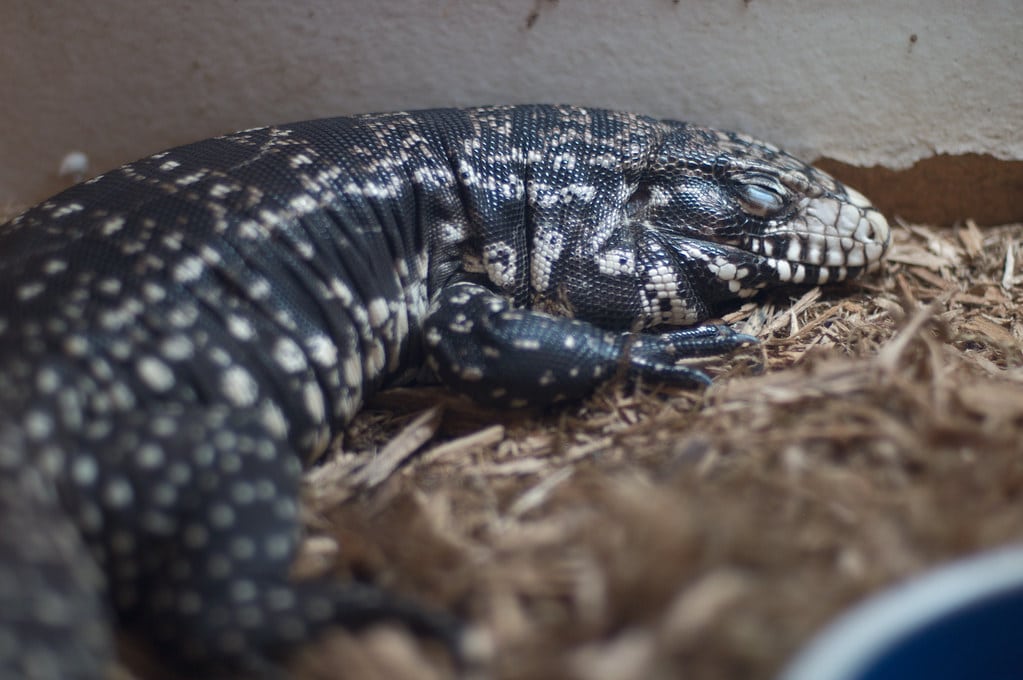
At between 3-4.5 feet, the Argentine Black and White Tegu is by far the largest species on our list, but is a great choice for those looking for something exotic and unique.
As the name might suggest, Argentine Black and White Tegus have gorgeous black and white markings which can vary from appearing as spots, to speckles, dapples, splotches, and stripes.
In very simplistic terms, the Argentine Black and White Tegu can be viewed as the reptilian equivalent of a small dog, living to around 15 years and up.
They are also very intelligent – in fact, one of the most intelligent of all lizards.
They even be taught basic tricks, and can recognise you as their owner as well as recognise their own name.
Tegus can even be taught to walk on a leash, and from young juveniles can be frequently handled. This is a great factor for beginner owners looking for a more active and hands-on reptile owning experience, as other lizards can be more reclusive and prefer minimal handling.
They are also very hardy lizards, meaning that handling does not need to be a worry.
In terms of housing, the Tegu will require a cage of around 4-6 foot by 2 foot, but may need to be even larger when dealing with adult males.
As with many lizards, they require UVB lighting and a temperature-controlled environment.
They also require a thick layer of substrate which they can use to burrow in. Finally, a must-have for Tegus is a spot to hide. The option that most owners choose is a long log for the Tegu to hide in.
This log is often lined with damp moss to aid with shedding and increase humidity.
When not interacting with you, it is likely that your Tegu will spend most of its time in this hiding place.
Tegus also have a great temperament and are naturally tame and docile creatures.
With the correct handling from a young age, they can form a strong bond with their owners and even show affection in their own way.
Tegus do require a varied diet, and while this can take some time to perfect, experimental meal times can also be a great bonding experience.
Most of the Tegu’s diet will be meat based, typically insects and pinkies, but they also enjoy fruits and vegetables too.
One very important thing to note about this information is that it pertains only to the Argentine Black and White Tegu, and not other Tegu subspecies such as the Columbian Black and White Tegu, as these lizards can be quite aggressive and much more complicated to correctly care for.
Common Types of Pet Lizards that Beginners Should AVOID
While as of yet, all the lizards mentioned on this list are great for beginners, we also wanted to give a brief mention to some of the breeds that first-time lizard owners should avoid, typically due to the specialist equipment, handling, or care they require.
- Iguanas – This may be a surprise entry as these lizards are both popular and affordable, but Iguanas are certainly not beginner friendly. This is down to how big these lizards can get, requiring a large enclosure of around half the size of an average bedroom if not bigger. Iguanas can also become quite aggressive if not handled correctly, and with a lifespan of around 20 years, they are also a very long-term commitment.
- Savannah Monitor – Savannah Monitors are also cheap to buy as babies, but like iguanas grow very large and require an extensively sized enclosure. They also grow to be very powerful lizards, with a whipping tail that can cause injury, even break bones, and have a strong bite as well. They also require intensive care, requiring lots of food, and cleanup, and can also do large amounts of property damage.
- Green Anole – While the Green Anole is inexpensive to purchase and only lives around 3-5 years, it requires specialised and expensive lighting and controlled environments. The Green Anole also becomes stressed easily when handled, and requires daily insect feeding.
- Chameleon – Chameleons only live for about 3-5 years, but can be easily afflicted with parasites or diseases. They are not suitable to be handled, as they can become easily stressed and injured, and also require an expensive set up.
- Monitors (in general) – Monitors are inexpensive to buy as babies, but will require a setup that can costs thousands of dollars, becoming larger and larger as they reach maturity. They also, in regards to lizards, have a fairly long life span, so certainly are a long-term commitment. They can be as intensive to care for as a dog, and will require large amounts of food.
The Best Pet is the Best Fit
If your chosen lizard isn’t on our above list, then it certainly doesn’t mean that the breed you’ve fell in love with isn’t good, or is flawed. It may simply be the perfect fit for you where it may not have been for others.
No matter the lovely lizard you choose, you’re sure to have a wonderful companion on your hands. From kooky and personable breeds such as a Bearded Dragon or Leopard Gecko, or beautiful to observe, such as the Crested Gecko or Red Ackie, or a loyal companion such as the Argentine Black and White Tegu, there are plenty of great options for beginners. If you follow the advice in this article, as well as under go your own thorough research, you’re sure to find the right fit for you.